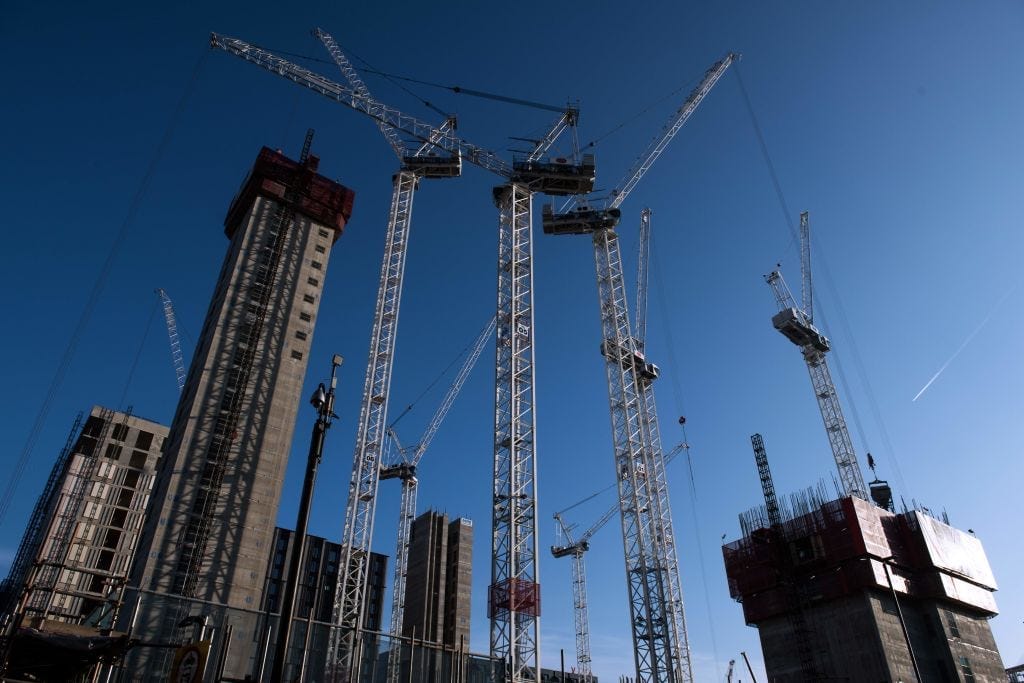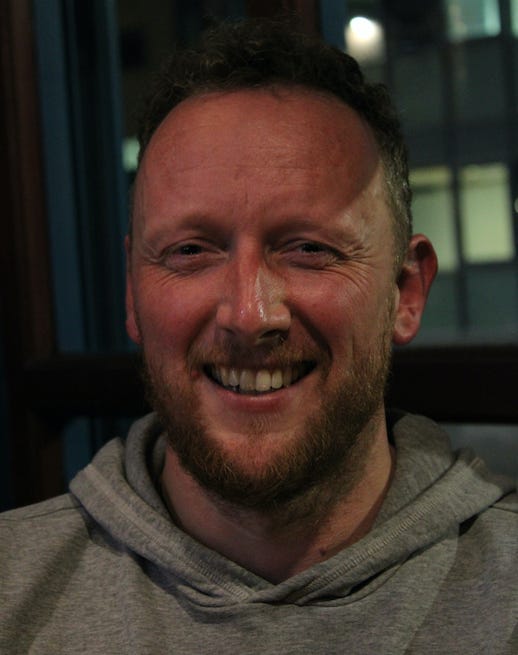Adam Green first became interested in tower cranes when standing on a busy site one day. Construction sites are deafening places, but amongst all the clamour, Adam watched a twenty-tonne container float away silently. “'The crane is God' as they say on site.”
For the best part of two decades, Adam, 38, has been working as a crane operator. It’s a job which requires a person to function a little like oxygen — rendering them invisible and essential. A modern-day construction site can’t function without one but onlookers and the people working on-site would be hard pressed to ever see the operators, cloistered as they are hundreds of feet in the air. Adam quotes one of his old site managers: “you’re just a voice on a radio.”
According to CityCo, a city centre management company, there are currently 333 developments in Greater Manchester either under construction or with planning approved. The latest Deloitte crane survey found that construction activity in Manchester increased by a third in 2021. In 2018, when Deloitte registered the highest number of new schemes in the past decade, the number of cranes on Manchester’s skyline peaked at 64. That’s because the types of buildings which have been constructed in Manchester over the past decade could not be built without cranes.

The most important piece of machinery on a multimillion-pound construction site is operated by a single person. Crane operators can sit in their cabs — effectively tiny control rooms that get as hot as a greenhouse with a one-way radio blaring instructions — for over 12 hours a day without coming down. Over that time, they battle an assembly of challenges: heights, weights, demanding foremen, and what Adam describes as “stressed idiots.”
Adam once believed himself to be the sort of person who excelled under pressure. He liked to spin multiple plates: have music playing in the cab, forward plan the next few lifts, speak to someone on the phone. “I used to think that was my happy place,” he said.
But, the implications of lifting tonnes of concrete over dozens of people — and the sustained focus that alone required — took a toll. "I've really enjoyed being a crane driver,” he tells me. “And I say 'being' because I want to get out."
One year, he was given an Apple Watch as a gift. He checked his resting heart rate while he was up in the crane. It was 120bpm, 40 beats above the average resting heart rate. “That made me think: how many years has that had on my life? And is that worth it?”
“Heart attacks are quite rife in our industry,” says Keiran Jones, an ex-Army sniper in Afghanistan, who now drives cranes. His past career isn’t as far removed from his current one as it might initially seem: both jobs require a person to spend lots of time alone in a high place. He joined the army when he was 22 — “a late-starter” — and served for eight years, he’s been a crane operator for the past six: “I’ve walked off building sites more exhausted than I have off fighting patrols,” he tells me.
He’s worked in Manchester, but has also travelled across the country to work, something his army experience helped with: ”If you’re willing to go anywhere at a moment’s notice, you’ll do well at [crane driving]. And, when you look at the army; that’s basically the same thing.”
Construction has burnt him out, Keiran admits. The machinery is incredibly dangerous, and firms are backwards in their thinking: they want to see a crane moving at all times, but the more a crane is moving, the more risk it poses. “Mental health is a big concern. Because of the long hours, and if you’re on a job with a toxic environment,” he tells me. According to the Office for National Statistics, the suicide rate amongst male construction workers is three times the national average.
“It’s just an egotistical, classic toxic-male environment,” Keiran tells me. It starts on the ground, but it always works its way back up to him in the cab. “Blackhats” — foremen, who wear black helmets on site — often set off a chain reaction of negativity. They shout at one subaltern, who shouts at another, and another and so on until it reaches his radio. “It’s a cascade of negativity,” and, at the top of their crane, it’s something operators are left to deal with alone.
Solitude means crane operators must be comfortable with their own thoughts. Often, the only person they’ll have contact with throughout the day is their banksman, who fields requests from contractors on the ground, who are all vying for crane time. They’ll climb the crane alone, work alone, eat alone. Adam and Keiran both describe a sense of anxiety as they gaze down from hundreds of feet in the air and wonder what people are saying about them.

The sense that someone could be talking about you can snowball into concern that everyone is talking about you. Wondering why the crane isn’t moving, criticising the way you are doing your job. Adam said that, of the ten people who were in his crane licence class, he was the only one still doing it after a year of completing the course. "That point where they look down, and they think people are talking about them, that's probably the deciding factor as to whether they take that next job."
But their separation from others can also help them to cultivate specialist abilities. Keiran can read a conversation entirely from body language. Adam has worked out how to gauge someone's mindset without the aid of facial expressions: “coughing is stress related,” he theorises, “if I hear someone cough on the radio, I slow down."
Back in September, I stood on Oldham Street, in the Northern Quarter, with a smattering of others. We watched as a crane operator was tied to a stretcher and slowly lowered from about 100ft.
He had fallen ill in his cab — the consensus on the ground was a heart attack, though this was never confirmed. Two passing workmen said they saw the operator slumped over from the vantage of their site. Others chipped in with cheap bravado: “That’s nothing, seen them ones in Malaysia? They put cranes on top of cranes.”
Rumours continued to brew on the curbside, the most credible being that the heat caused it. It was a late summer day, and crane cabs are famous, as unshaded and high up as they are, for reaching temperatures unbearable for the operators inside. In 2020, Unite the Union called for all construction firms to install air conditioning units in all of their crane cabs.
Possible heat isn’t the only thing that keeps a crane driver’s eye trained on their weather app. When I ask Adam what most torments a crane operator, he leans in.
“Wind.”
Cranes are not, as one might presume, rigid structures. They are more like 100-metre-tall sticks of bamboo, set in about four feet of concrete. In the wind, a crane is designed to lean, bend, and — thanks to this flexibility — not snap.
For a driver this is terrifying: trapped in a confined space high above ground, flung to and fro by the wind. Anything above 20mph is a challenge: loads can swing out of control, drivers may have to break against the wind to keep the load steady, bending the tower of the crane. “The crane is leaning over a few degrees, (but) your body tells you it's 90 degrees,” says Adam.

If winds pick up while an operator is in a crane, it’s best practice to release the brake mechanism, point the crane downwind and essentially turn the structure into a massive weathervane. Once winds hit 40mph, like in Monday’s storm — which was strong enough to uproot trees and paralyse transport networks — a crane cannot legally operate.
But it doesn’t always play out like that. Operators, the vast majority self-employed, can be pressured into driving a crane in high winds. The crane is the heart of the site, after all, and construction time frames are tight, especially in Manchester’s white-hot property market where developers are sprinting to get their flats and offices on to the market. Managers are promised bonuses if they hit targets, and I’ve been told this conflicting interest can mean drivers who stand their ground are sacked. “I’ve walked off sites because I’ve been told to get it done or go home,” says Keiran.
Other operators — known in the industry as “wind heroes” — will gain a reputation as the type of operator you can call on a windy day. This may be a good plan in the short term, but it’s not a reputation that bodes well for a long career. Word will get around that they’re a liability; they may serve that site manager’s needs on a windy day, but that doesn’t mean that manager will still want a reckless driver when things clear up.
Both Adam and Keiran describe a reductive attitude toward safety and overwork. "You've got one right: health and safety. And, that one right you do have, is laughed at, ignored, and belittled as much as possible,” says Adam. They feel that their colleagues lack an understanding of how stressful the work is, as if the fact they’re sitting down makes it easy.
Often, a foreman will see a crane that isn’t moving — usually a sign things are going well — and want to know why. This normally leads to jobs being made up, known in the industry as “bullshit lifts,” like picking up a ladder or a saw someone doesn’t want to carry up some stairs. "What I do is a high-risk operation,” says Adam. “So, in my head I'm like: no, let's keep our high-risk operations to a minimum. But that falls on deaf ears.”
In my conversations with Adam and Keiran, I was regularly struck by just how many buildings they had had a hand in. I’d mention a story or a building and they’d chime in: “I worked on that.” It could be the towers at Deansgate Square, a ward of a hospital, or the Ancoats building that houses the restaurant Mana. Surely, despite the stressful working conditions, that’s satisfying?
"I hate the work environment, but I love building things that have a positive impact,” says Adam. Working on drab office buildings, or in Adam’s words: “very tall boring buildings with small allocated living quarters for its occupants, that no one working on [the site] can afford to buy,” is repetitive, monotonous and rarely rewarding. But, better jobs do crop up. For example, Adam worked on the proton therapy unit at The Christie: “a horrible job, but what you're building is fucking amazing,” he says. But, for now, both Adam and Keiran want out of crane driving.
In fact, they want out of construction all together. Keiran’s looking to open his own business. Adam is hoping to make an unexpected segue into game design, he always felt like the controls to a crane were like a superpowered Xbox controller, anyway — "I didn't need a Covid situation to realise this isn't what I wanted to do when I'm 65 years old."

Comments
How to comment:
If you are already a member,
click here to sign in
and leave a comment.
If you aren't a member,
sign up here
to be able to leave a comment.
To add your photo, click here to create a profile on Gravatar.






